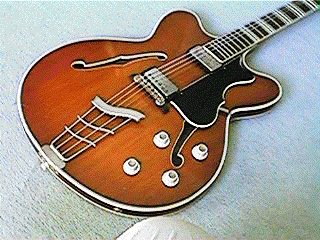A Gretsch experience

Last Sunday was a real treat for me because I played a Gretsch electric guitar for the praise and worship set at church. It was lent to me by a friend who wanted to hear it being played by someone else; he’s in a retro band and plays regularly with his Gretsch, but he had never heard it from a distance. Of course I agreed, and what an experience it was!
I don’t know when he bought the Gretsch and for how much, but when I saw it I could guess that it was worth several thousand dollars (multiply by 51 to get the peso value). It was, he said, a “Vegas” model, although when I later tried to find it in the internet I couldn’t find it, not even in the Gretsch website itself.
It was a red solidbody guitar, with a mahogany body and neck and rosewood fretboard. Its most distinctive feature was the fretboad markers: instead of dots or blocks or strips, it used images of dice in keeping with the Vegas theme (a three on the third fret, a two and a three on the fifth, etc.). It was very heavy, but when I strapped it on it felt very balanced, very comfortable. The strings on it were medium electrics with the third string wound, so it was pretty heavy. But the neck on it was so incredibly silky smooth that the heavy gauge was not a problem.
Unplugged, the Gretsch gave out a refreshing shimmer when strummed or plucked; it was “alive,” and I could tell right off that it was going to sound great plugged. At church I plugged it into a Peavey amp and as I had anticipated it gave a full bodied sound that had an acoustic-guitar ring to it. With the silky-smooth neck and incredibly rich sound, the Gretsch Vegas was quite possibly the best guitar I had ever played.
It’s just too bad that I don’t have a picture to prove that I actually played it. My wife took some great shots, but our digital camera suddenly went bonkers on us and wouldn’t be recognized by our home computer, and I inadvertently reformatted the SD card without realizing that the photos of me playing the Gretsch were in it. And as I said before, a search on the internet for any info or photo of the Gretsch Vegas proved futile, so I’ll have to ask the owner to take some pics of it so you’d know what it looks like.
Suffice it to say that my Gretsch experience was totally awesome (to quote my five-year-old nephew Miggy who lives in Michigan) and that I really did fall in love with it. Too bad I had to give it back, but at least I have the assurance I can borrow it again. Can’t wait!










